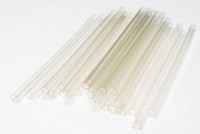Advertisement
Grab your lab coat. Let's get started
Welcome!
Welcome!
Create an account below to get 6 C&EN articles per month, receive newsletters and more - all free.
It seems this is your first time logging in online. Please enter the following information to continue.
As an ACS member you automatically get access to this site. All we need is few more details to create your reading experience.
Not you? Sign in with a different account.
Not you? Sign in with a different account.
ERROR 1
ERROR 1
ERROR 2
ERROR 2
ERROR 2
ERROR 2
ERROR 2
Password and Confirm password must match.
If you have an ACS member number, please enter it here so we can link this account to your membership. (optional)
ERROR 2
ACS values your privacy. By submitting your information, you are gaining access to C&EN and subscribing to our weekly newsletter. We use the information you provide to make your reading experience better, and we will never sell your data to third party members.
Business
Cutting out Phthalates
Polyvinyl chloride applications haven't been flexible enough to accept alternatives to phthalate esters
by Alexander H. Tullo
November 14, 2005
| A version of this story appeared in
Volume 83, Issue 46

COVER STORY
Cutting Out Phthalates
Phthalate esters, used to make polyvinyl chloride (PVC) flexible, face a handful of prohibitive regulations and a ton of bad publicity. Although controversy over phthalates has helped spur some substitution by other products—as well as replacement of PVC by other polymers–the cost-effective plasticizers are still entrenched in many regions.
Few chemicals on the market today have undergone as much scientific scrutiny as phthalate esters (see page 32.) And environmental and industry groups pitted against each other in the debate have no shortage of studies they can use as ammunition.
The environmental groups cite studies linking doses of some phthalates to reproductive problems in rodents and to damaged sexual development in neonatal infants. Industry groups counter that phthalates and adverse health effects in humans never have been indisputably connected.
The debate, and the years of bad press it has generated, is starting to yield modest regulatory restrictions. In Europe, starting in 2006, three phthalate esters—including di(2-ethylhexyl) phthalate (DEHP), the highest volume phthalate—will be permanently banned for use in toys, and another three—including diisononyl phthalate (DINP)—will be banned in toys that can be mouthed. The European Union has also banned some phthalates in cosmetics.
Japan has a ban in place for DINP and DEHP in toys as well as a ban on DEHP in food-handling gloves. California has proposed similar bans on phthalates in toys.
And beyond the regulations, there have been voluntary phaseouts. Health Care Without Harm, an activist group that campaigns against the use of phthalates and PVC in medical products, lists dozens of companies that make DEHP-free or PVC-free products, such as blood bags, feeding sets, and even body bags.
And plenty of nonphthalate plasticizers for PVC do exist. In a paper presented at the Plasticizers 2004 conference in Brussels, Arnold Tukker, program manager for sustainable innovation at the Dutch research organization TNO, listed trimellitates, aliphatic dibasic esters, phosphates, benzoates, citrate esters, polymeric plasticizers, sulfonic acid, chloroparaffins, and sorbitol as potential substitutes. But, he pointed out, whereas phthalates are multipurpose plasticizers that find broad application, this is not always the case with the alternatives. He now adds that, because alternatives are more expensive than phthalates, they will not be broadly tested unless bans on phthalates are imposed on industry.
As a result, phthalates remain the dominant class of plasticizers. According to the Houston-based consultancy Chemical Market Resources Inc. (CMRI), they compose about 87% of the 10.4 billion-lb-per-year world market for plasticizers.
CMRI President Balaji B. Singh expects phthalates to continue to remain dominant. He sees more of a stalemate than a threat. For example, the use of DEHP in applications like medical devices and toys will continue to be controversial in developed countries, but it will remain an insignificant issue in developing countries.
Robert S. Brookman, vice president of business development at Teknor Apex, explains how price is the biggest barrier to substitution. Teknor Apex says it is the third largest compounder of PVC in the U.S. And unlike the two larger firms, Georgia Gulf and PolyOne, its business is almost exclusively in flexible vinyl and largely in grades for medical applications. The company also makes some of its own phthalate, adipate, and trimellitate plasticizers.
We've had people come to us asking for alternative compounds, Brookman says. We offer four to five different types. We send out a lot of samples of materials, and when we're asked to quote the price, no one ever orders any.
He explains that DEHP, dominant in medical applications, is inexpensive compared with alternatives. Adipates, trimellitates, and citrates cost about 50%, 100%, and 140% more, respectively. Plasticizers can make up a third, by mass, of compounded PVC. Thus, an alternative can drive up the cost of a PVC compound from about 80 cents to about 95 cents per lb. People like to do the right thing, or what they would consider to be the right thing from a green standpoint, but are not willing to pay for it, Brookman says.
Dwight M. Lyman, global marketing manager for ExxonMobil Chemical's global oxo chemical business, seconds Brookman on the issue of price. The other plasticizers that are out there that are not phthalates, that are technically alternatives, in almost all cases cost more money, he says.
Although ExxonMobil is one of the largest phthalate ester producers in the world, it also makes nonphthalate plasticizers such as adipates and trimellitates. Lyman says these tend to be used in applications where they are the optimal plasticizers because of their performance, not for environmental reasons. Adipates, for example, are used in shrink wrap; trimellitates are used in high-performance wire.
Nevertheless, chemical firms are hardly ignoring the controversy. BASF, reacting to a 50% plummet in DEHP demand in Europe since 2000, is discontinuing production of DEHP and its raw material 2-ethylhexanol (2-EH) in Ludwigshafen, Germany. In Europe, the company is introducing Hexamoll Dinch plasticizer, a 1,2-cyclohexanedicarboxylic acid diisononyl ester whose health safety is beyond all question, it says.
Martha Brabston, BASF's business director for oxo alcohols and plasticizers in North America, says the new product is a response to pressures on molecules like DEHP. It was launched by BASF in Europe to help customers comply with regulations in that region, she says.
BASF says it has received a positive response in Europe, where the plasticizer is being used in toys and medical devices such as feeding tubes. The company has 25,000 metric tons of annual capacity for the product and says the potential market for such applications is 260,000 metric tons per year.
In the U.S., BASF is also making production adjustments, albeit not for regulatory reasons. It is converting a 2-EH plant in Pasadena, Texas, to make 2-propylheptanol (2-PH), which it will use as a feedstock for the new plasticizer dipropylheptyl phthalate (DPHP). But the company will continue to sell DEHP in North America.
Overall, ExxonMobil's Lyman says, growth in the phthalate ester market is nearly equal to the global growth in flexible PVC, which is about the same as global economic growth. He takes that as a sign that alternatives haven't made many inroads into the phthalates market.
But companies are still trying. Eastman Chemical, for example, is marketing Eastman 168, a terephthalate plasticizer, according to Erin Bernhardt, the firm's manager of plasticizers and specialty materials. It is a good fit for customers that are becoming more concerned about the controversial pressures, she says. The product is being used in consumer goods, and Eastman is seeking other uses for it, such as food contact applications.
Another Eastman plasticizer, TXIB (2,2,4-trimethyl-1,3 pentanediol diisobutyrate), is not a phthalate, but Bernhardt says it is sold on its properties-its low viscosity makes it a natural plasticizer for PVC gloves-more than as an alternative to phthalate esters.
The private investment firm Arsenal Capital Partners last month purchased two companies that have nonphthalate plasticizers in their stable: Reilly Industries, which offers citrate ester plasticizers, and Velsicol, which makes benzoate plasticizers.
David Gleeson, president of Reilly's Morflex unit, says the company was selling citrate ester plasticizers long before phthalates were controversial. We always presented them as an alternative material based on what citrates have to offer, he says. They can be used at lower temperatures than phthalates, he notes, and less plasticizer is needed to do a similar job.
But Gleeson recalls that citrate esters started to be perceived as an alternative to phthalate esters in the late 1990s, as the issue began to get more attention. Some of the major consumer product makers, specifically for toys, started to seek alternative products, he says.
Though Gleeson concedes his products are more expensive per pound than phthalates, he says the extra cost translates into something like a 5-cent increase in the final cost of a typical finished article. Reilly is seeing 10% annual growth for citrate esters in applications such as toys, and about 7% growth overall, Gleeson says.
Richard A. Moras, director of business management for Velsicol, says his company's benzoate esters have been a substitute for phthalate esters since the 1970s in white glue. Since then, they have found use in vinyl applications such as flooring, wall covering, and gaskets.
Moras concedes there is no direct substitute for phthalate esters. There is this heightened awareness, but the direct alternatives aren't out there, he says. If there was one, he notes, it would undoubtedly be popular. If you could flip a switch and the cost and performance were the same, converters would say, Why wouldn't we do that?'
Using other plasticizers isn't the only way to get rid of phthalates; another is using other polymers such as polyethylene.
Eastman's Bernhardt says a sign of weakness in flexible vinyl is that its growth rate is only a fraction of the growth rate of polyethylene. The fact that flexible PVC is growing at only a 2% sort of rate tells me that we are seeing a decline and that people are looking at alternatives, she says.
Despite the phthalate controversy, CMRI's Singh points out that the polymer has inherent advantages in many applications because it is versatile and cheap to make. In a perfect world, PVC is not the best material, he says. But on a cost-benefit analysis, PVC is the poor man's plastic.
As controversial as they sometimes are, phthalate esters are an inexpensive way to make a polymer more flexible. And, in fact, no one in the PVC industry expects phthalates to go away any time soon. Even those selling alternatives aren't so optimistic. People think alternative products will take over the market, but that really is not the case, Reilly's Gleeson says.






Join the conversation
Contact the reporter
Submit a Letter to the Editor for publication
Engage with us on Twitter